![]()
![]()
![]()
Use LEFT and RIGHT arrow keys to navigate between flashcards;
Use UP and DOWN arrow keys to flip the card;
H to show hint;
A reads text to speech;
123 Cards in this Set
- Front
- Back
|
overall organization of neural structures involved in the control of movement
p |
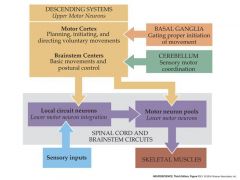
|
|
|
draw knee tap reflex
p |
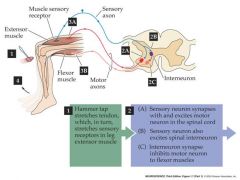
|
|
|
where are lower motor neurons located?
p |

|
|
|
how was the organization of lower motor neurons determined?
p |
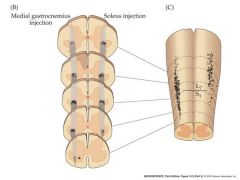
Retrograde transport of tracer molecules from muscle back to motorneuron
Cell bodies shows that different groups of motorneurons innervate each muscle |
|
|
talk about what motor neurons innervate in regards to a single spinal column
p |
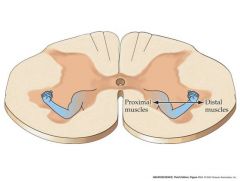
|
|
|
what is a motor unit?
what does it innervate p |
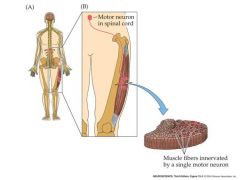
A “motor unit” is a single motorneuron and all of the muscle cells that it innervates
|
|
|
how many motor neurons is a muscle innervated by?
|
A muscle is generally innervated by several different “types” of motor neurons, each contacting muscle fibers (cells) with distrinct properties, creating different types of motorunits.
|
|
|
compare the force and fatigability of three different motor units in regards to grams of force and time
p |

begining is where motor neuron was stimulated
|
|
|
recruitment of motor neurons in cat under different conditions
p |
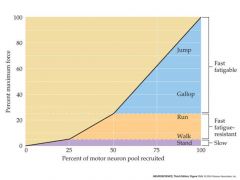
As the use to which the muscle is put changes, so different motor unit types
are recruited by the nervous system to drive contraction |
|
|
the effect of stimulation rate on muscle tension
p |

a.p. frequency in the motor unit determines contraction strength.
|
|
|
diagram of increase in voluntary force and number of motor neurons
p |

Different motor units generate different ranges of force and so are active during
Different strengths of contraction |
|
|
So the nervous system controls muscle contraction by:
|
1) recruiting the right types of motor unit for a task
2) varying the a.p. frequency within those motor units by controlling the rate of a.p’s in the motorneurons |
|
|
2 examples of control of motorneuron activity at the spinal cord level?...no picture
|
spinal reflexes
e.g. the stretch reflex – serves to maintain limb position despite varying loads. e.g. holding a mug while it is being filled with beer |
|
|
draw stretch eflex circuitry
p |
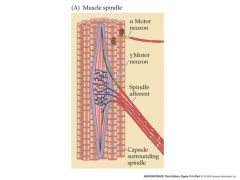
muscle spindles detect stretch of muscle...
A motor neuron comes from spinal cord and drives main conraction Spindle afferent goes to spinal cord and activity increases with stretch Gamma motor neuron regulates activity of spindle afferent |
|
|
draw the mug reflex response
p |
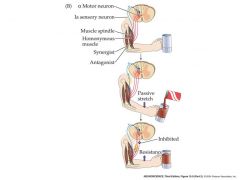
Stretch activates spindle sensory
neurons Spindle sensory neurons activate flexor Muscle alpha motoneurons (and inhibit extensor motorneurons) Arm is raised! Beer is saved!!!!! |
|
|
stretch reflex circuitry negative feedback loop....mug example
p |
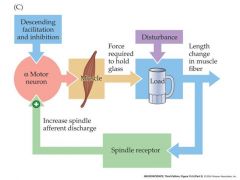
|
|
|
draw role of gamma motor neuron diagram
p |
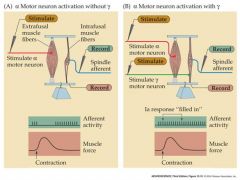
Gamma activity prevents spindle from becoming floppy and
“silent” during voluntary contraction – maintains usefulnesss of reflex even during contraction |
|
|
what do spinal reflexes allow?
|
So spinal reflexes are feedback circuits that allow muscles to respond rapidly
to changing loads. |
|
|
what is another role for local spinal circuits?
ex? p |
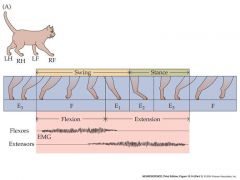
Another role for local spinal circuits is in rythmic generating patterns of activity – like those created during walking
- spinally-transected cats show ryhtmic firing of motor neurons while“walking” on a motor-driven treadmill each limb has its own central pattern generator responsible for alternating flexion and extension transection of spinal cord proves following... Rythmic, alternating, muscle contractions Are still recorded despite the transection Of the spinal cord - Rhythm must be locally generated see 6b of 11/18 for picture |
|
|
example of central pattern generators?
p |

lobster is the picture
cat walking the pattern is retained without future input. |
|
|
basal ganglia
|
The basal ganglia (or basal nuclei) are a group of nuclei in the brain interconnected with the cerebral cortex, thalamus and brainstem. Mammalian basal ganglia are associated with a variety of functions: motor control, cognition, emotions, and learning. In modern use the term 'ganglia' is in this instance considered a misnomer; 'ganglion' refers to concentrations of neural nuclei in the periphery only (for example those of the autonomic nervous system), and the term 'basal nuclei' is preferred.
|
|
|
how does the brain control the action of muscles?
|
1) pathways from brainstem (upper motor neurons) to the spinal cord...lower motorneurons
2)Pathways from cortical (also called upper) motorneurons to the spinal (lower) motorneurons ...direct and indirect 3)modulated by basa ganglia 4)modulated by cerebellum |
|
|
draw 4 descending projections from the brainstem to the spinal cord
p |
11/25
1c and 1d |
|
|
draw direct cortical projection pway
p |
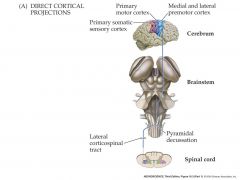
Note:
Neurons in left cerebral Hemisphere drive Spinal motorneurons on the Right hand Side of the body Motor cortex driving right Hand side of body is Just in front of sensory cortex receiving Info from right Hand side of body 11/25 2b more lateral when linking w/ spinal cord in comparison to indirect pway |
|
|
indirect cortical projection
p |
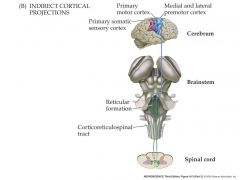
more medial when linking to spinal cord
|
|
|
lateral and medial view of primary motor cortex.
p |
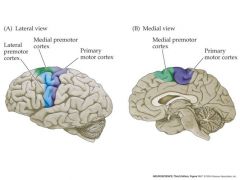
|
|
|
topographic map of they body musculature in the primary motor cortex
p |

much more coarse in comparison o somatosensory tract
|
|
|
diagram showing the influence of a single cortical upper motor neurons on muscle activity
p |
11/25
3c and d |
|
|
when are cortical neurons active?
|
just before movement begins
|
|
|
two major structures that modulates cortical motorneurons activity
|
basal ganglia
cerebellum |
|
|
motor components of the human basal ganglia
p |

from caudate to nigra reticulata is basal ganglia cells.
basal ganglia is a group of cells. |
|
|
draw feedback loop of human basal ganglia
p |
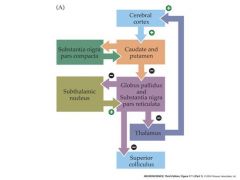
The basal ganglia seem to be
Involved in a feedback circuit that Controls cortical motorneuron activity loop from thalamus is feedback loop MN: C N call pat while he's on a sub globing N with a thalamus that's cool |
|
|
basal ganglia and one thing it is involved in
p |
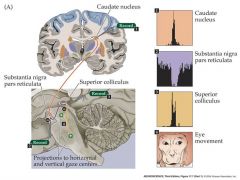
saccadic eye movement is fast eye movement that searches for stuff
substantia nigra pars reticulata is active when fixating a target 1)GABAergic neurons activate caudate 2)this decreases retiulate output. |
|
|
the the apikes of the 2 cells responsible for saccadic eye movements and describe
p |

brown is superior colliculus and this occurs during saccadic eye movement
light blue is substantia nigra which is normally spontaneously active and allows one to fixate on a target. |
|
|
components of the brainstem and diencephalon related to the cerebellum
p |

|
|
|
diagram of functional organizatin of inputs to the cerebellum
p |
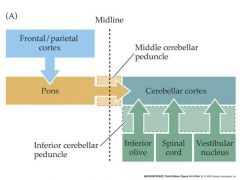
|
|
|
neuronal pway of functional organization of inputs to the cerebellum
|

|
|
|
summary diagram of motor modulation by the cerebellum
p |
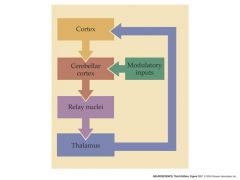
|
|
|
talk about vestibulo-ocular reflex in monkeys and show experiment
p |
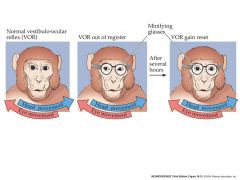
Resetting is not
learnt after cerebellar damage Eyes still do Not follow target 1)eyes follow target 2)eyes do not follow target 3)eyes follow target reflex operates to move the eyes as the head moves so that image remains stable minifying spectacles cause eyes to move too far. The brain accounts for this in time and it causes eyes to move less.......in cerebellar damage there will not be this learnt response. |
|
|
habituation
|
decrease in response to repeated stimulus presentation
|
|
|
sensitization
|
generalization of an aversive stimulus to non-aversive stimuli
aversive: unpleasent stimuli |
|
|
picture of Aplysia californica
p |

|
|
|
draw cells of aplysia californica
|
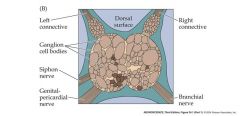
|
|
|
draw 2 sets of graphs that show habituation and sensitization in Aplysia gill
p |
12/02 1d, 2a
|
|
|
synaptic mechanisms underlying short-term sensitization in aplysia californica
p |

this type is heterosynaptic facilitation
|
|
|
show motor neuron epsp after activating siphen sensory neurons at 0min 20 min and 50min and then stimulating tail nerve at 51 min
p |
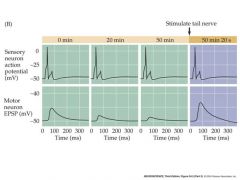
3 first 3 parts are when the siphen sensory neurons are activated
|
|
|
presynaptic depression
|
-Depletion of the presynaptic NT vesicles
-Inactivation of N-type Ca2+ channels |
|
|
mechanism for presynaptic enhancement underlying behavioral sensitization for short term.
p |

PKA enhances glutamate release
short term changes occur because of post-translational mmodifications |
|
|
rule for short-term changes in synaptic strength
|
Short-term changes in synaptic strength are mediated by post-translational modifications
|
|
|
Mechanism of presynaptic enhancement underlying behavioral sensitization long term
p |
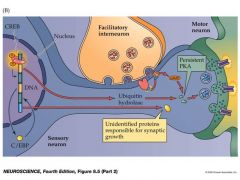
caused by changes in gene expression...aka mediated by protein synthesis.
|
|
|
long-term change synaptic strenght rule
|
Long-term changes in synaptic strength are mediated by protein synthesis (translation +/- transcription)
|
|
|
what were lessons learned from a slug
|
-short-term changes in synaptic strength are mediated by posttranslational modifications
-long-term changes in synaptic strength are mediated by protein synthesis (translation +/- transcription) -”memory molecules/cognitive kinases” |
|
|
genetics of learning and memory in the fruit fly.....2 things
p |
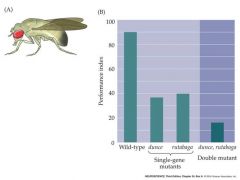
Classical conditioning in
Drosophila: pairing an aversive stimulus (shock or bright light) with an odor results in avoidance of that odor graph shows that mutant flies were bad at learning MUTANTS ARE DEFICIENCIENT IN PKA SIGNALING........ Gene mutated in rutabaga is adenylyl cyclase Gene mutated in DUNCE is a phosphodiesterase (PDE) degrades cAMP BIDIRECTIONAL DISRUPTION = UNCOUPLING PKA ACTIVATION FROM EXPERIENCE |
|
|
mechanisms of synaptic plasticity.....4
|
HETEROSYNAPTIC = ACTIVITY AT ONE SYNAPSE REGULATES THE STRENGTH AT ANOTHER (DIFFERENT) SYNAPSE
HOMOSYNAPTIC = ACTIVITY OF A SYNAPSE REGULATES THE STRENGTH OF THAT (SAME) SYNAPSE -Presynaptic (change in the amount of NT released) -Postsynaptic (change in the response to the NT released) |
|
|
draw membrane potential diagram of homosynaptic short-term plasticity......
p |
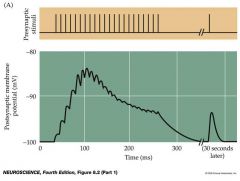
1)increase in curve: facilitation
2)decrease in curve: depression 3) no change: rest 4) 30 seconds later: post-tetanic potentiation shows that communication outlasts tetanus. |
|
|
potentiation
|
improvement in communication between 2 neurons
|
|
|
PRESYNAPTIC SHORT-TERM FACILITATION
|
STIMULATION FREQUENCY > CA2+ BUFFERING CAPACITY
= SUMMATION OF PRESYNAPTIC CALCIUM = INCREASE IN P |
|
|
PRESYNAPTIC SHORT-TERM DEPRESSION
|
STIMULATION FREQUENCY > VESICLE RECYCLING
= DEPLETION OF NEUROTRANSMITTER VESICLES = DECREASE IN P |
|
|
POST-TETANIC POTENTIATION
|
HIGH FREQUENCY STIMULATION PHOSPHORYLATES SYNAPSIN
= RELEASE OF SYNAPTIC VESICLES FROM RESERVE POOL = INCREASE IN SYNAPTIC VESICLES IN ACTIVE POOL = INCREASE IN P |
|
|
reserve pool diagram
p |
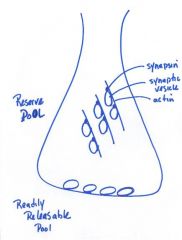
|
|
|
homosynaptic short-term plasticity location
|
presynaptic locus
|
|
|
homosynaptic long-term plasticity location
|
postsynaptic locus
|
|
|
mammalian hippocampus purpose
|
encodes spatial information
consolidates short-term into long-term memories |
|
|
learning
|
change in behavior over repeated trials
|
|
|
memory
|
retention of something learned (time)
|
|
|
experiment in mice that showed need for hippocampus
|
morris water maze experiment.
-mice were placed in a kiddy pool with mercy water so that they could not see platform -the room had visual cues so that they new their location -after 10 trials, mice were able to find the platform with ease so that they could rest -results showed need for hippocampus because in hippocampus lesioned samples, they showed no improvement in finding the platform. 12/02 8d if needed. |
|
|
draw rodent hippocampus
|
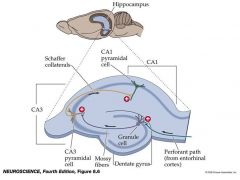
|
|
|
experiment that showed long-term potentiation of schaffer collateral-CA1 synapse
|
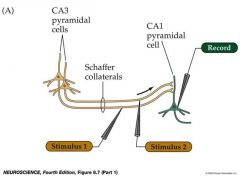
12/04 lecture see 1b,c,d as well
path 1 had a high frequency stimulus....path 2 did not .....tetanus is what occured in response to their own stimuli strength |
|
|
how is LTP caused?
p |
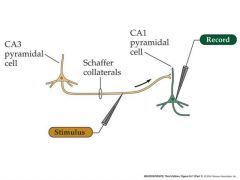
by pairing presynaptic and postsynaptic activity
a single stimuli does not increase synaptic strength....this only occurs when the CA1 is depolarized by applying current pulses through the recording electrode also see12/04 2b |
|
|
talk about NMDA receptor and LTP
p |
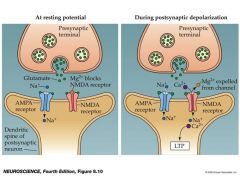
the nmda receptor channel can open only during depolarization of the postsynapic neuron from its normal resting level.
depolarization expels mg2 from the nmda channel allowing current to flow into the postsynaptic cell. this leads to ca2+ entry, which in turn triggers LTP |
|
|
draw signaling mechanism underlying LTP of NMDA channel
|
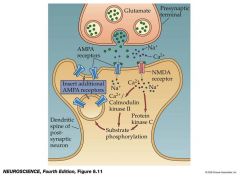
during glutamate release, the NMDA channel opens only if the postsynaptic cell is sufficiently depolarized. CA2+ enters the cell throug the channel and activates postsynaptic protein kinases.
These postsynaptic kinases trigger a series of reactions that leads to insertion of new AMPA receptors into the postsynaptic spine, thereby increasing the cell's sensitivity to glutamate. |
|
|
requirement for LTP
|
presnaptic activity
postsynaptic depolarization |
|
|
Why is LTP a good model for memory formation?
|
-Activity-dependent
-Shows specificity and associativity -many manipulations that degrade memory degrade LTP |
|
|
specificity vs. associativity
p |
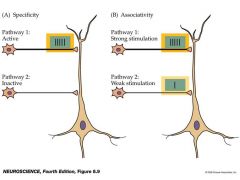
in B, pathway 2 does not have LTP unless
|
|
|
draw the current that would be seen before and after LTP that caused AMPA channels to be inserted
p |
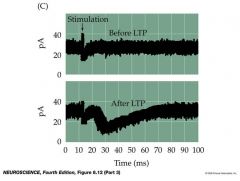
|
|
|
what would appear if you fluoresced a cell and looked at it after LTP?
p |
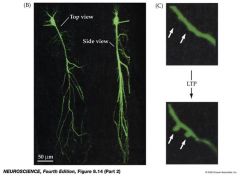
spines would be present...this is what the arrows are
|
|
|
experiment that shows role of protein synthesis for maintaining LTP
p |
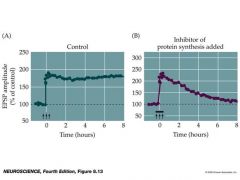
repetitive high frequency stimulation ...arrows...induces LTP that persists for many hours in A...
In B, Treatment with anisomycin, an inhibitr of protein synthesis, causes LTP to decay within a few hours after the hih-frequency stimulation |
|
|
short-term vs. long-term NMDA LTP diagram with both in one
p |
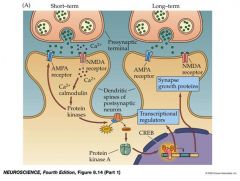
|
|
|
Long-term synaptic depression in the hypocampus
|

a low-amplitude rise in calcium concentration in the postsynaptic CA1 neuron activates postsynaptic protein phosphatases, which cause internalization of postsynaptic AMPA receptors, thereby decreasing the sensitivity to glutamate released from the Schaffer collateral terminals.
|
|
|
association cortices
|
Underlie cognition “To know the world”
To attend to, identify/recognize , and plan for interaction w/external stimuli or internal motivation. |
|
|
lateral and medial views of the human brain showing extent of the association cortices
p |
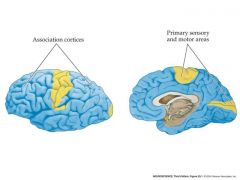
blue is assoiation cortices which is much bigger area in omparison to primary sensory and motor areas
|
|
|
canonical neocortical circuitry diagram
p |
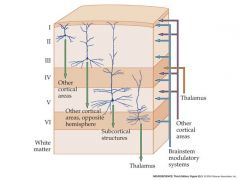
thalamus, other cortical areas, and brainstem modulatory systems on the right side of picture are inputs
each circuitry has inputs and outputs |
|
|
methods of non-invasive imaging
|
CT: serial X-rays; better for hard than soft tissue
PET: positron emission; accumulation of radioactive metabolites fMRI: magnetic resonance; functional anatomy EEG: electrical activity; physiological response |
|
|
experimental strategies to localize a function (3)
|
-lesion studies
-non-invasive imaging in humans -stimulate/record from experimental animals |
|
|
damage to parietal cortex can cause what?
|
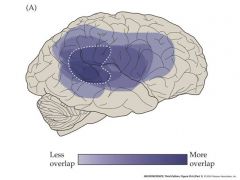
deficits of attention
cause inattention or neglect of something right lesion, affects left side |
|
|
3 tasks that prove someone has a lesion in parietal cortex and name?
p |
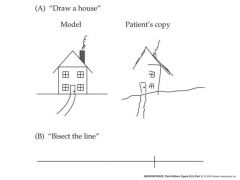
contralateral neglect syndrome
also the picture with the lines where the patient has to cross out all lines, but only crosses out the right sides remember, a left side lesion of parietal cortex will affect the right side of view. |
|
|
what is more important for attention, the right or left parietal hemisphere?
|
a right parietal lesion results in severe left neglect, whereas a left parietal lesion leads to only minimal right neglect due to preserved attention within the right hemisphere.
|
|
|
draw PET scan revealing metabolic activity of parietal cortex on both sides during activation
|
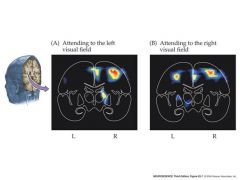
shows that right parietal lobe is much more highly active....
|
|
|
neuroanatomy of attention....draw the different types of lesions
p |
12/9 2d 3a
|
|
|
different lobes of brain and where a recording via electrode would test for attention
|
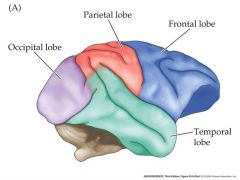
would find it in the parietal lobe
|
|
|
procedure that showed response to stimuli is mediated in parietal lobe in monkeys
p |
12/9
3d, 4a Monkey had recording electrode surgicall placed in head. A stimuli was placed on the screen: pair of simultaneously illuminated targets When animal paid more attention to stimuli, it was given more juice The more juice a particular monkey received, the more they would focus on the screen, and the more their parietal cortex would be active. |
|
|
two words to explain what temporal cortex does?
|
identification/ recognition
|
|
|
Agnosia
|
not knowing
----different from the case where one can't draw the left side of the house: these patients do not know that the left sides exists. Agnosia patients can see the image, but are unsure of its place in the world object generally |
|
|
prosopagnosia
|
face blindness; can see faces and can have perfect vision , but are unable to recognize faces from one another
.....faces are described as blurred often times .....often times can look out of the corner of their eyes to recognize faces |
|
|
what would be shown of the brain during an fMRI during a face recognition exercise
|
increased activity in the right temporal lobe
|
|
|
monkey face experiment
p |
12/9 5c,d
electrode was place in the inferior temporal cortex for recording 1) in one set the monkey had the highest response in frontal views of the face 2) in another set, it responded best to profiles |
|
|
180 of face picture
|
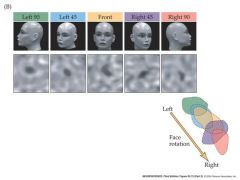
shows columnar organization of object representations in the inferotemporal cortex...each column(going down) has a certain point of view that it works best at.
|
|
|
inferior temporal cortex location
|
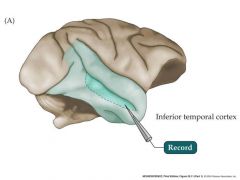
|
|
|
dorsolateral prefrontal cortex
picture purpose p |
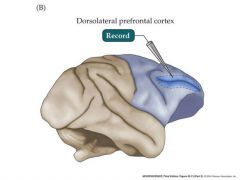
planning
|
|
|
experiment showing activity in the prefrontal cortex
|

when experiment is performed with no food as a reward, there is less activity in the prefrontal cortex
12/9 6d if you want to see a.p |
|
|
explain a neuropsychological testing test
|
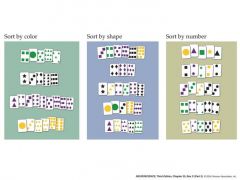
wisconsin card sorting
1)4 cards are already sorted 2) after 10 correct trials, examiner will say wrong and the patient must sort in some other method ...individuals with frontal lobe lesions have trouble with this because of deficits in planning. |
|
|
brain size and intelligence
|
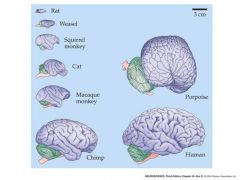
-smarter animals tend to have larger brains overall and in comparison to their total body size
-this study done among humans is very controversal because of racial issues ...hard to determine what exactly constitutes smarts between humans. |
|
|
synaptic plasticity
|
potential for synaptic function (strenght) to be regulated by experience (activity)
|
|
|
experiment that showed that pathway of a particle from the eye
|
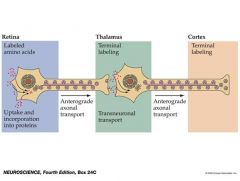
-used radioactive amino acid labeling
1)tissue fixed 2)sectioned 3)placed on glass slides 4)coated with photographic emulsion 5)radioactive decay will show up as silver grains to form in the emulsion Experiment showed where the pathway actually goes.... From eye to lateral geniculate nucleus to layer 4 in primary visual cortex. |
|
|
experiment that shows deprivation in a kittens eye versus in an adult cat eye
p 2 important points |
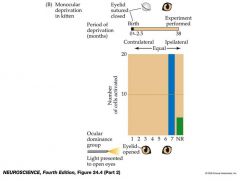
1 is only right eye......7 is only left eye.....in between is a combinatino of both
results showed that if a kittens eye was sutured, it would not get better once removed.... In an adult it would get better if removed. see 12/11 page 2 if needed. key points... 1) the juvenile cortex is more plastic than adults 2)vision is required for normal development of visual system. |
|
|
3 vs 6 days in deprivation in the kittens eye
|
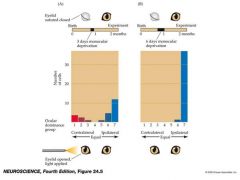
|
|
|
what did hubel and weisel receive a nobel prize for
|
1) function of cortex regulated by experience
2) plasticity highest during postnatal critical period -no changes in response properties of RGC's No changes in the response properties of the thalamus |
|
|
enriched environment vs standard environment (7)
|

“Enriched environment” paradigm results in::::
Enhanced cortical thickness!! Enhanced brain weight!! CREB-mediate gene expression expression Enhanced dendritic branching Enhanced oligodendrocyte to neuron ratio Enhanced number of synapses per neuron essentially standard environment leads to impoverished conditions enriched environment leads to stimulating conditions.... |
|
|
talk about london taxi driver case
|

results showed that taxi cab drivers had a larger posterior hippocampal section than that of non-taxi cab drivers.
...this is because this area is used to remember spatial information ....likewise when comparing taxi cab drivers among each other, drivers who had been on the job longer had larger posterior hippocampal sections. see 12/11 5a if needed |
|
|
draw memory flow diagram
p |

|
|
|
areas that, when damaged, tend to give rise to declarative memory disorders
|
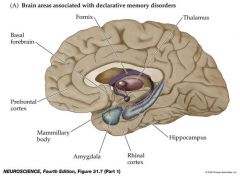
hippocampus is most important
called amnesia |
|
|
talk about the case of H.M. and what occured and what was removed
|
-performed surgery in which the amygdala, uncus, hippocampal gyrus, and anterior two-thirds of the hippocampus were removed.
-he performed well at everything, but he was unable to form declarative memories. |
|
|
conncections between the hippocmpus and possible declarative memory storage sites
|
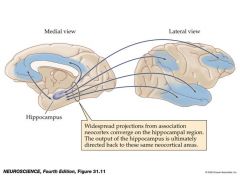
memory is not stored in the hippocampus, but instead only integrated
|
|
|
dementia
|
Dementia (from Latin de- "apart, away" + mens (genitive mentis) "mind") is the progressive decline in cognitive function due to damage or disease in the body beyond what might be expected from normal aging.
|
|
|
Talk about Alzeimer's disease
|
Alzheimer’s disease: most common form of progressive dementia
10% of people over 65; 45% of people over 85 Only 1% (early onset) AD has clear genetic basis (presenilin 1 and 2, apolipoprotein E) Early signs: retrograde amnesia, progress to anterograde amnesia ** personality changes Late signs: Language skills, problem solving, judgement Definitive diagnosis is only post-mortem |
|
|
amnesia
|
Amnesia (from Greek Ἀμνησία) is a condition in which memory is disturbed. In simple terms it is the loss of memory. The causes of amnesia are organic or functional
|
|
|
plaques are...
tangles are... |
extracellular
intracellular |
|
|
talk about histological hallmarks of AD
|
In 1907, in the first report, Alois Alzheimer described senile plaques (SP) and neurofibrillary tangles (NFT)
SP are found in neocortex, hippocampus and in several subcortical areas NFT density correlates with disease duration and severity of dementia. |
|
|
draw difference between neurofibrillary tangle and plaques
|
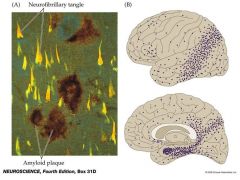
|
|
|
draw the signaling pathways and processing of things in AD patients
|
12/11
7b,7c,6c 6c..... Molecular and cellular processes presumed to participate in AD pathogenesis. Aァ peptides produced by neurons and other brain cells aggregate into a variety of assemblies, some of which impair synapses and neuronal dendrites, either directly or through the engagement of glial loops. Build-up of pathogenic Aァ assemblies could result from increased production or aggregation or from deficient clearance mechanisms. ApoE4 and tau promote Aァ-induced neuronal injury and also have independent adverse effects. Microglia could be beneficial or harmful, depending on which of their signaling cascades and functions are engaged. This multifactorial scenario leads to progressive disintegration of neural circuits, isolation and loss of neurons, network failure, and neurological decline. 7b...... Drug targets involved in Aァ production and assembly. Aァ production depends on sequential proteolytic cleavage of APP by ァ-secretase (marked 1), also known as ァ-site APP-cleaving enzyme 1 (BACE1), and the multiprotein -secretase complex (2) (88). -Secretase targets include the enzyme's active site, substrate docking site, and ATP-binding site (2a to 2c) and its predilection for -versus -cleavage (2d) or for generating Aァ42 versus Aァ40 (2e). The pathogenicity of released Aァ peptides depends on self-assembly (3). APP cleavage by -secretases (ADAM family metalloproteases) prevents Aァ production (4). Caspase cleavage of the APP intracellular domain (AICD) generates a C31 fragment (5) that may participate in Aァ-induced toxicity or act independently. 7c.......... Plaques and tangles in Alzheimer's disease. Amyloid plaques contain the A peptide, which is produced from the amyloid precursor protein (APP). Cleavage of APP at one point (not shown) generates a carboxy-terminal fragment. This is then severed by the ypsilon-secretase complex (which consists of at least four proteins10 — presenilin-1, APH-1, PEN-2 and nicastrin), producing A-beta. Tangles are produced from hyperphosphorylated tau protein, possibly by means of the enzyme glycogen synthase kinase-3 (GSK-3). GSK-3 also regulates phosphorylation of beta-catenin (which can bind presenilin-1). Phiel et al.1 find that GSK-3 might also regulate — either directly or indirectly — the cleavage of APP carboxy-terminal fragments. They show that lithium and kenpaullone (two GSK-3 inhibitors), as well as small interfering RNAs that prevent GSK-3 expression, inhibit A-beta production. So, GSK-3 inhibitors might interfere with the generation of both amyloid plaques and tangles in Alzheimer's disease The precise roles of the two forms of GSK-3, alpha and beta, are unknown. |
|
|
do transgenic mice that mimic changes seen in AD patients have similar cognitive deficits?
|
no
|
|
|
vulnerable neurons in AD (6)
|
HAM BEN
Basal forebrain cholinergic system (nucleus basalis) Monoaminergic system Hippocampus (CA1 and CA2 pyramidal cells) Amygdala Entorhinal cortex Neocortex |
|
|
drugs approved for treatment of AD
|
Don Galluped the River to get the Tac in his Memory......AD
Mild to moderate AD: cholinesterase inhibitors Donepezil Galantamine Rivastigmine Tacrine Moderate to severe AD: NMDA receptor antagonist Memantine -acetylcholinesterase (AChE) inhibitors (donepezil (Aricept), rivastigmine (Exelon) and Reminyl (Razadyne) All prevent the breakdown of acetylcholine, to keep ACh levels high despite the loss of Ach producing cells -non-competitive low affinity N-methyl-D-aspartate (NMDA) receptor antagonist Memantine (Namenda) Memantine protect cells against excess glutamate (and toxicity) by partially blocking NMDA receptors. |

